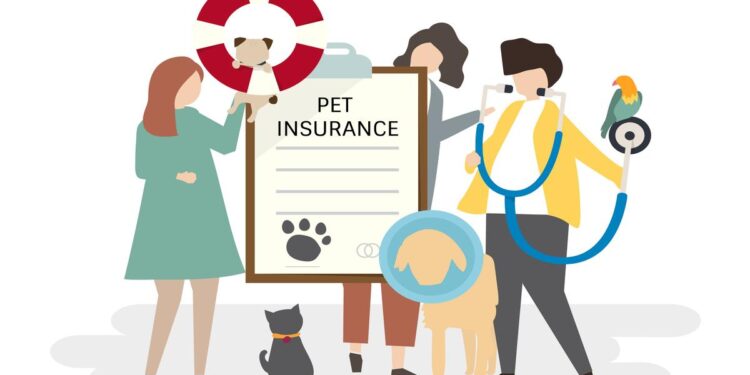Despite the complexities, the social and emotional relationships are majorly akin to a parental relationship with a child. The purge of affections of the humans and their beloved pets for each other is undeniable. Love explains the urge to provide the best possible life for your pet, and pet insurance plays a crucial part in the schedule.
The devotion and unconditional love your pet shows you at your best and your worst are admirable, and hence you are contemplating every possible way to give your pet the most amazing life possible. The following comprehensive guide will provide you with a detailed outlook of whether pet insurance is worth it.
Pet insurance is a significant chunk to ensure that you can take the best possible care of your pet. As per the statistics, 67% of U.S. households own a pet which equates to nearly 85 million homes. With veterinary care’s charger soaring high, pet insurance provides you with the perfect financial balance, ensuring that your pet receives the best care.
While pet insurance is a relatively new industry, its inception date does not undermine the countless advantages it can provide. One can safely conclude that your pets’ best interest is at heart, and this article will help you determine whether or not a pet insurance policy is part of that for your family. We’ll talk about how pet insurance works and explain the process.
What is pet insurance?
Term it as a luxury of necessity; taking care of a pet can be expensive, given the costs of veterinary care are rapidly rising. Maintaining the balance between affording your pet’s best care can be challenging, and pet insurance is the perfect solution.
So what is pet insurance? Pet insurance helps you cover the cost of veterinary treatment if your pet falls ill or gets injured. The insurance providers also pay if the pet dies, is lost or stolen, harms someone, or damages property. In simpler terminologies, pet insurance works as your rescue angel if you are burdened with an expensive vet bill. The standard insurance will reimburse you and will help cover the costs of diagnostics, procedures, and medications to treat your pet’s accidents or illnesses.
Apart from aiding in covering veterinary treatment, the analyzed scores of pet insurance policies have left thousands of pet insurance policyholders satisfied and quite content with the smooth working and substantial reimbursements.
Pet insurance works as a knight in shining armor, given the hefty amount of unexpected veterinary costs, delivering peace of mind for pet owners. Pet owners often overlook pet insurance. Still, after battling the coronavirus, the inflation rise has resulted in pet owners pondering on this insurance to ensure their pet’s health.
What does pet insurance cover?
Pet insurance empowers you to do the right thing for your pet, but the question arises what does the pet insurance cover? It covers the cost of vet fees and can cover amounts ranging from £1,000 to £15,000.
The working of pet insurance is quite synonymous with renter’s insurance as it is paid on a month-to-month basis. A monthly premium is delivered to your insurer for coverage as the policy outlines the reimbursement rate, deductible, and maximum payout. The reimbursement rate is the amount paid back by the pet insurance company for the cost of care. Limits are defined as the conditions about how much and what type of care your pets might need.
The majority of the pet health insurance plans reimburse the policyholder rather than pay the vet directly. The policyholders get refunded within 5 to 9 days after submitting a claim. Here are some steps one has to follow to get the payment from the pet insurance company
- Pay the vet bill during your visit.
- Submit a claim to your insurance company.
- Get reimbursed for 70% to 100% of covered expenses (After the deductible is met)
Companies use an annual deductible which is the portion of the veterinary bill the policyholder is responsible for before the reimbursement begins. However, depending on your insurance plan, your policy may not cover every condition/expense your pet has. This is why it’s so important to find a plan that covers your pet’s breed-specific health risks.
Delving into details about what is covered by pet insurance, we have listed the following pointers that focus on the conditions and significant factors that facilitate the policyholders.
Death by accident or illness – The reimbursements also include the payment refund in the scenario where your pet dies from death or disease. It is the cost of what you paid for it or what it could sell.
Insurance policies and age limit – Like other insurance policies, pet insurance policies have a limit after which insurers will not pay out, and the policyholder will have to contribute to costs.
Missing pet cover – The policy also contributes to the costs of putting up posters and paying a reward if the pet goes missing.
Third-party liability– The insurance policy will pay the pet owner when your pet injures someone or damages property, and the insurance policy will pay the pet owner.
Overseas travel cover – Many insurers also offer cover for lost travel and accommodation costs if you’re forced to cancel a holiday because your pet becomes life-threateningly ill when you are all set to travel.
Cremation and burial – The policyholder is also facilitated with the pet’s cremation as the insurance company covers burial costs and expenses.
Furthermore, many other medical charges are also included in the insurance, which are listed below:
- Unexpected injuries/accidents (like foreign object ingestion, broken bones, and more)
- Unexpected illnesses (like cancer, glaucoma, hip dysplasia, parvovirus, and more)
- Surgery (like cruciate ligament tears, cataracts, and more)
- Medication and Tests/diagnosticsEmergency exam fees
Most pet insurance plans will cover the expenses mentioned above as long as they are not related to a pre-existing condition. However, some pet insurance companies might provide additional benefits that are listed as follows: Alternative therapies, Behavioral modification, Hospital boarding, and many more.
What does pet insurance not cover?
Pet insurance provides a plethora of coverages depending on how much you are willing to spend. The benefits include a wide array of coverage. But like every other niche-focused insurance, pet insurance has its fair share of exclusions and restrictions that are not covered. We will now discuss the restricted conditions, some of which might apply to all pets while others apply to certain types.
Exclusions outnumber the covered conditions; hence when considering pet insurance, make sure the list of exclusions is reviewed in detail. Exclusions are typically found in a section titled “What’s Not Covered” on the insurance company website.
Below were list down some of the most common exclusions found in pet insurance policies contract:
Waiting Period – The waiting period is defined as the time ranging from 10 to 30 days during which there is no coverage. Following the policy, any problem that appeared during the waiting period will not be covered.
Pre Existing Medical Conditions – The most usual exclusion is for pre-existing medical conditions that focus on the pet’s medical condition history.
Pregnancy and Birth – If your pet(cat or dog) becomes pregnant, the insurance company will not be held accountable for paying for those expenses. Some policies offer coverage in the event of complications, but most consider pregnancy excludable.
Death or Theft of a Pet – The theft or death of a pet is usually not covered by regular pet insurance.
Bilateral Condition – Anything that might happen to both sides of the pet’s body is excluded. These include hip dysplasia, cataracts, etc.
Preventable Diseases – If the policyholder’s pet is not vaccinated against diseases like canine influenza, giardia, and parvovirus, then the treatment will likely be excluded from coverage
Breed Exclusion – Some pets are excluded because of their breed that can be carriers of certain troublesome medical conditions like diabetes or ligament injuries.
Age Exclusion – The insurance companies can often refuse to allocate policies to pets(cats and dogs) that have reached the extreme of the age spectrum. Let’s take this example to understand the age exclusion policy where insurers will not write a policy for 14 years old or older pets.
Elective Procedures – The elective procedures are not covered, and examples include anal gland expression and removal, tail docking, ear cropping, nail trimming, and much more.
Nonstandard/Non-Veterinary Services – Procedures are not customarily associated with veterinary services and include waste disposal, food, nutritional supplements. The benefits do not cover behavioral training and the cost of compliance.
Is pet insurance worth it?
Determining whether the insurance is worth it or not can be a tricky task because, let’s be honest, first and foremost, making decisions and getting your priorities are more demanding than they seem on the outlook. Amid battling a pandemic and facing rapid inflation, one might be torn in making such decisions.
However, for the simplification of the process of decision-making, two significant factors must be kept in accordance to have a crystal clear insight about your requirements and path to fulfillment. The first factor is self-explanatory and makes you analyze your finances. How much can you afford easily if your beloved pet gets injured and is in a severe emergency? The second factor is determining how much tolerance you have or, in simpler words, how much anxiety and pressure you can quickly curb in.
Your financial plan and budget won’t be disrupted by minor medical problems like upset stomach or ear infections, but significant injuries will surely cost you a hefty amount of cash. At that moment, it’s far better not to regret and have acquired pet insurance.
Like there is a flip side to every coin, pet insurance can also prove futile, and the policyholder might end up paying an insurance premium for years and never receive the benefit. The frugal thought process might be relatable initially, but once faced with the potential risk of losing the pet, the guilt shakes the person to the core.
Before investing in the insurance niche, one should calculate all the expenses and be mindful that insurance ensures a safe financial nest in case of alarming risk. For inexpensive treatments and annual wellness exams, you’ll pay out of pocket with or without insurance.
As for dipping our toes in the economic angle, the cost of pet insurance varies depending on where you live, your pet’s age and breed, and the level of coverage you want. The policyholder pays between $25 and $70 to ensure your dog. For cats, it pays between $10 and $40 a month.
Point to be noted, the following cost mentioned above can vary greatly given they can be lower or higher depending on how much coverage a pet owner wishes to have. Let’s take the following example; one can increase the premium in exchange for a larger payout when the pet receives an eligible treatment.
Purchasing a policy can get puzzling. Hence, getting a quotation regarding the charges from the insurer’s website is advisable. Further, one can also compare various pet insurance plans to pick the policy that best matches your budget and pet health. Because pet health insurance doesn’t cover preventive care, the only real benefit of buying coverage is for accident and illness protection.
Additionally, most policies are customizable and allow policyholders to choose their deductible, reimbursement level, and annual or incident maximum. Ranging from $0 to $1,000 for most plans, the deductible must be paid beforehand before insurance kicks in. As for the reimbursement options, they are usually available from 50% to 100%. The annual and incident maximums range varies from as low as $1,000 to higher than $15,000.
In conclusion, It is essential to note that pet insurance is different from human health insurance. Inhuman health insurance companies promise to cover pay for medical fees upfront. In pet insurance companies, the policy is implemented so that the owners pay for medical bills and then apply for reimbursement. Due to the lengthy process, some policyholders also express frustration at the reimbursement process and are surprised to learn that certain conditions aren’t covered.
What are the main types of pet insurance?
While there are different pet insurance policies, all of them have similar attributes and core functionality. Primary, there are three types of pet insurance. The following types are discussed in detail below.
Lifetime cover pet insurance
First and foremost, we will discuss lifetime policies that are undoubtedly one of the most popular and most comprehensive types of pet insurance available in the market. These types listed above following types payout indefinitely for treatment over your pet’s lifetime.
Lifetime policies can work in various ways, keeping in view the annual limit. The policies pay up to a specified amount on vet fees each year. Like this, in every given year, the insurer pays a handsome sum. In other occurrences, the type of life policy is condition per year. This way, the annual limit for each situation is fixed, and in the worst case, the policyholder can make claims related to the pet’s diabetes.
Delving into the details, the lifetime policies pay a minimal annual amount with a smaller yearly benefit within this for any single condition. The usage of multiple figures makes up five claims or five unconnected conditions. Still, the policyholder gets a slashes amount towards a succession of costs involved in treating the pet’s illness. It proves that the higher the limit, the more expensive the premium is bound to be. However, keeping aside the size of the boundary is, with a lifetime policy, one can rely on the company to occasionally make ongoing contributions towards the pet’s conditions.
Non-lifetime cover pet insurance.
Next up, we ponder the second type of pet insurance, which significantly focuses on a considerably lesser period despite hefty premiums and a plethora of preconditioned restrictions. The non-lifetime cover is less comprehensive than the lifetime policy, but it eliminates various conditions after one exceeds the limit.
The category of non-lifetime cover pet insurance is divided into two divisions: the per condition cover and time-limit per condition cover.
Per condition pet insurance is defined as the type of insurance policy that pays a limited amount for each condition. Once the limit has been reached and succeeded, the insurance company stops covering it and doesn’t keep track. Suppose the following scenario to better understand your pet is suffering from an eye infection. But your per condition cover limit for eye infections is £5,000. So once you exceed the limit, the insurer will no longer pay for eye infections claims, even after you renew your policy.
Next up, we have a time-limit per condition pet insurance cover that covers both a monetary and time limit. The range of this insurance is a maximum of 12 months before the conditions are excluded. Once the conditions end, the insurer is no longer responsible for covering expenses.
Accident only pet insurance
Last but not least, there is accident-only pet insurance which is the cheapest and most basic type of pet insurance. The following insurance does not cover illnesses, but as the name suggests, it covers accidents like various types of injuries. Furthermore, the accident-only policies aim to provide a fixed sum of money for each accidental damage. The following amount helps to pay off the pet’s extensive treatment. However, it is pertinent to notice a fixed limit to this type of policy as it will eventually stop paying after twelve months.
Advantages of pet insurance
Once you have determined the type of pet insurance that will suit you the best, the next step is evaluating the advantages. Your quest for knowledge for undermining pet insurance’s working has led you to dig in articles about how pet insurance works. That demonstrates your fondness for your beloved pet.
The adorable relationship between a human and it beloved pet is the purest thing. Both rely on physical affection and are stress busters for each other. Considering a pet feels like a member of the family, the process of its insurance is lengthy and hectic. The pet insurance company sees the pet(cat or dog) less as a family member and more as property. But don’t let this designation misguide you.
Elaborating further, the pet insurance functions work more like property insurance than health insurance. Some pet lovers might protest and reinforce that their pets are more like their children and less like some lifeless property. One should understand that showing outrage works against their favor as pet insurance contracts are considerably easy to write, read and comprehend, given the policy is a cakewalk.
Now, we will be discussing the countless reasons that can be easily termed as the advantage of availing the pet assurance.
Choice of Vet – As long as the vet is licensed, pet insurers won’t tell you whom you can and can’t see. There are no out-of-network doctors like those your health insurance policy probably dictates.
Simple Policies – Another significant benefit of pet insurance is simple policies that make it easier for policyholders to go through and analyze all of the listed conditions. For starters, most companies have only three tiers from which to choose. There is accident-only, or primary, coverage; accident and illness, or comprehensive, coverage; and wellness coverage.
Cheap Premiums – Additionally, many insurance policies aim to support various plans. The insurance costs vary with coverage and policy. Despite the range, the wellness coverage costs $20 to $25 per month, accident-only coverage runs $11 (for cats) and $16 (for dogs) per month, and accident and illness coverage averages $29 (for cats) and $49 (for dogs) per month. It is essential to mention here that the cost depends on an avalanche of variables like breed, age type and size of the pet, where you live, and the options you choose as part of your policy.
Despite having simpler mathematics, one must be capable enough to understand the complexities of the insurance world. Then it will be substantially easier to grasp the perplexing concept of the pet insurance policy. Let’s take an example to gain a comprehensive guide towards this. Consider you are a policyholder who has a pet and wishes to pay a monthly or an annual premium. Keeping in mind that you have to pay a deductible, there is a possibility that you might have a copay. Since deductibles can range from $0 to $1,000, the co-pay will range somewhat between 10% and 30% of the cost.
Glimpsing towards the difference between human healthcare policies and pet health policies, the pet owner or policyholder should pay off first rather than the insurance company. How does pet insurance work, and how will this benefit you? Once you have paid, the next step is to file a claim with your pet insurance provider and wait for the claim to be confirmed.
Not all the vet docs, but a section of veterinarians allows the policyholder or people with insurance to forgo payment until the insurance company pays its portion.
How much does pet health insurance cost anyway?
After majorly contemplating the knows and hows, let’s now discuss how much does pet health costs anyway? The average annual routine care costs between $200 and $400; however, routine care is not the prime reason why one might opt for pet health insurance. The driving force behind opting for pet insurance is the accident and illness part that can have a ride-or-die effect on your wallet. Unpleasant surprises and unexpected injuries can cost a hefty amount.
Delving into details about the statistical cost of pet health insurance, the cost to diagnose diabetes in a cat runs about $300. The treatment generally continues for the rest of the animal’s life and costs $240 to $360 per year. That will ultimately save a lot of cash for the pet owner in the scenario when they have ensured their pet.
Let’s take the following examples to understand how pet insurance policies will benefit various occurrences. If your pet develops heartworm, treatment could run between $400 and $1,000. Also, one keeps in view that emergency room care in the case of an injury-inducing accident could cost more than $1,000.
Hence, one could quickly arrest its case by concluding that the answer depends on various factors. But before availing of the commodity as mentioned earlier, the pet owner has to keep in mind that pet insurance is not entirely focused on the spectrum of investment. Pet insurance is generally affordable. The average monthly premium is $29 for a cat and $47 for a dog, but it’s essential to recognize that there’s a wide range in pricing depending on a few key factors like enrolling your pets when they are still young. Dr. William Hodges, DVM, Dr. Ricky Walther, DVM, Aliyah Diamond, Surgery Technician, and thousands of other veterinary professionals say “yes, it is worth it.”
Does pet insurance cover vaccines?
People are programmed to think that when one talks about a pet’s general health vaccines hold the utmost property. The notion can be termed somewhat correct and, to a major extent, wrong. If you as a pet owner, have frantically googled about pet vaccines, this is the right place to get rid of your preconceived confusions and walk out with confidence.
Vaccinations are not covered by pet insurance. Neither is spaying or neutering. Typically, pet insurance covers illness and injury, but general health care for things like dental cleanings and vaccinations isn’t covered.
But there’s a way where there is a will, so if you opt for a wellness plan, routine care like dental visits, vaccines, and even microchipping is covered. The definition of routine care depends on the provider, but almost all wellness plans recognize the importance of vaccinations. However, the wellness plans are not listed as pet health insurance.
Can older pets be insured?
Possibly, the pet owner has had their pet for a long time but does not know about pet insurance. Now, the pet is older, and you truly understand the importance of pet insurance. What to do now? For the starters, the following case requires extensive research and selecting the right insurance company. The older pets can be insured, but the insurance premium is slightly higher. Additionally, some insurance companies may have a maximum age limit for enrollment.
Does pet insurance cover pre-existing medical conditions?
What are pre-existing medical conditions that a pet might have? According to pet insurance, a pre-existing condition falls under the category of an illness or injury that started before coverage of the insurance. The time includes the waiting period.
There are reasonable grounds why prior conditional are not covered and catered. Pets have a shorter life span so the pet insurers can not avail the luxury of charging years of premiums in order to settle claims payments for pre-existing conditions.
Hence, the cost of treating pre-existing conditions and the relatively short lifetime of a pet generally exclude pre-existing conditions from coverage. The pet insurance companies put pre-existing conditions into two categories:
Curable pre-existing conditions
Curable pre-existing conditions are defined as curable medical conditions or diseases, and there are no symptoms for 180 days (excluding knee and ligament conditions). If the condition happens again after 180 days, it can be covered like a new problem. The examples of curable conditions are listed;
- Respiratory infections
- Ear infections
- Urinary tract infections and Bladder infections
- Vomiting and Diarrhea
Incurable pre-existing conditions
Incurable pre-existing conditions are diseases that require repeat veterinarian visits, ongoing medication, and sometimes even surgery. The fatal pre-pre-existing fatal are not covered by pet insurance and include the following conditions:
- Cancer and Diabetes
- Orthopedic condition
- Heart and Kidney disease
- Urinary blockages
- Epilepsy
What are the alternatives to pet insurance?
Generally, pet insurance is viewed as an excellent way for pet owners to receive financial protection for an unexpected situation that might help risk management. Despite the uncountable benefits, pet insurance is comprehensive and demands attention to detail. The procedure is rigorous with various stages like coverage limits, waiting periods, specific exclusions, costly premiums, etc.
Hence, pet owners might opt for peaceful alternatives, and there are a plethora of options launched in recent years that allow you to receive financial protection that best fits your budget and needs. Below we list down some popular pet insurance alternatives:
- Pawp: Emergency fund
- Pet Assure: Veterinary discount plan
- Rush: Community health-sharing plan
- Savings account
- Credit financing
- Financial assistance









